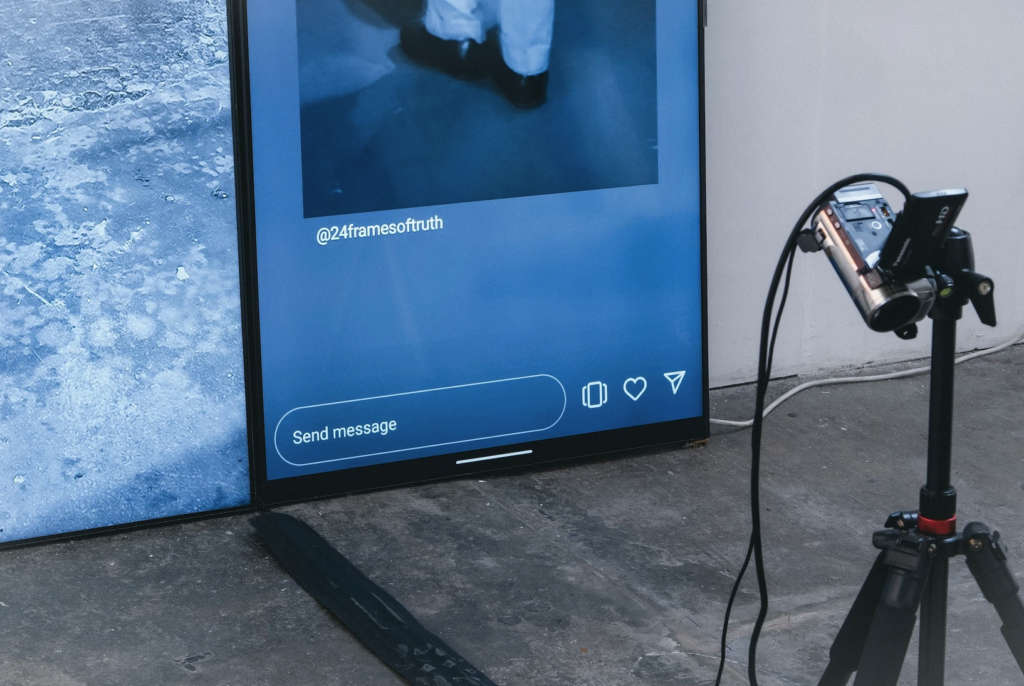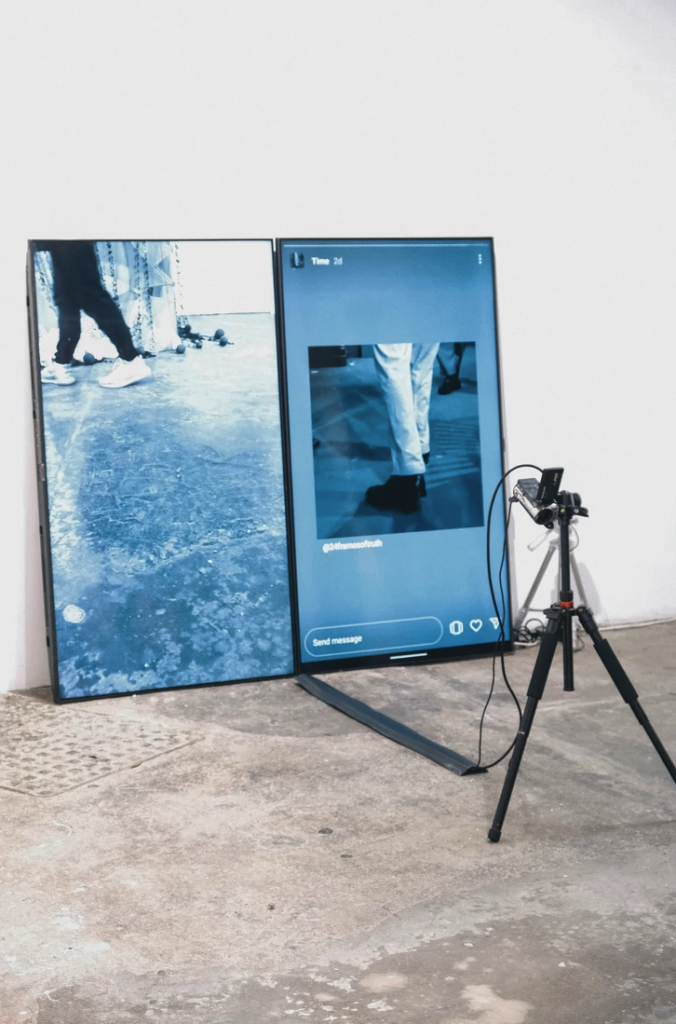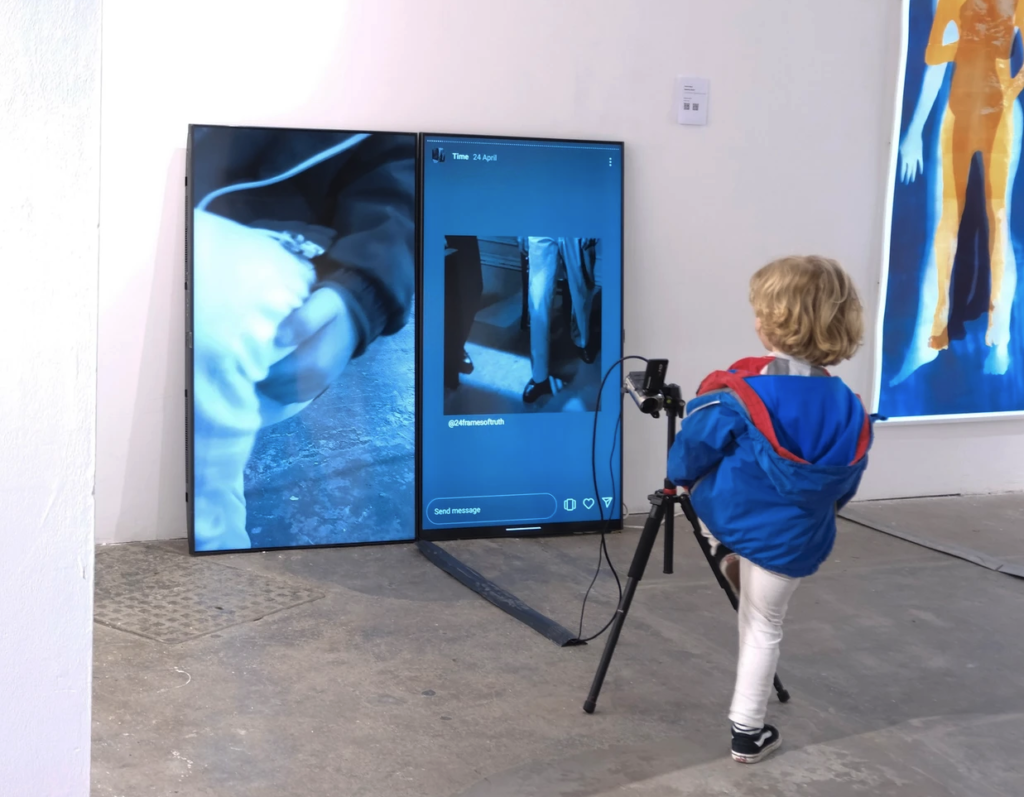Relativity
2024
Camcorder, TV Screens
Size Variable

@24framesoftruth is an Instagram page and art installation work that explores the relationship between films, social media and perception. Films, as an art form to represent and depict time, are commonly consumed on social media platforms as fragments. The epitome is TikTok which is designed specifically for users to receive constant stimulation with seconds-long videos. Paramount, a major Hollywood studio, has once released an entire film on the platform, chopped into 23 parts.
I go to the extreme and reduce film sequences into individual frames, then post them one by one on Instagram, the social media platform dedicated to still images. Making use of its interface, by scrolling through of the profile page, the film stills are restored as moving images.
The “materiality” of Instagram is used to look into how films, as a century-old art form, are consumed in the most “contemporary” way. An installation comprises of a phone, a camcorder and a projector is set up to invite viewers to scroll through the page themselves. While having fun, the viewer’s finger is also projected on screen. Its scrolling movement is connected to early cinema history, when films were screened by rotating the hand crank of the projector. The installation’s ergonomics captures the same mechanical action that made cinema possible a hundred years ago. Now everyone can become an “instaprojectionist”.
The work demonstrates how one can challenge perception towards an everyday interface by using it not the way one is told to, and opens ways for viewers to re-imagine their interactions with these interfaces. Viewers can also scroll the page on their own phone, appreciate individual frames out of a film sequence, and even show their appreciation by liking, commenting and sharing the Instagram posts. The work also plays with the parallel of films and social media, as both are made by weaving montage of one’s life to form a stream of time. It questions our urge of sharing our lives as montages on these platforms, and examines how these tools (and their interface) shape us to turn our daily routines into spectacles.
Instagram handle: @24framesoftruth
Scroll it yourself:
While the film 12 Angry Men is universally acclaimed for its quest on the reasonable doubt, I am more interested in its representation of time. I look into the scene in which the jurors re-enact the witness’s walking to his front door and seeing the suspect escaped, so as to check whether it is in the time he claims. The re-enactment is presented as a one-take shot of walking sequence, after which the juror announces that it takes 41 seconds to complete. In his essay On Time in Cinema that contemplates cinematic duration, Enrico Terrone lists 12 Angry Men as one of the examples of real time films. What he does not point out is that the scene of re-enactment only lasts for 30 seconds on screen, i.e. shorter than the event it portrays. Developed from my other work @24framesoftruth, I break down the sequence into individual frames and posted them on Instagram, this time using the Story interface. When looking at Stories, users tend to tap rapidly and skip to the next one. With this installation viewers are not allowed to skip through the Stories, making each post (the individual frame of the sequence) to stay for five seconds, which is the platform’s native setting. To experience a film in this way, a 30-second walking sequence would take an hour to complete. The whole sequence of Stories is displayed on a large TV screen, accompanied with an identical screen that is connected to a camcorder pointing to the ground. Putting both screens side by side, viewers can look at their own feet in one screen, and in real time, and compare their walking postures with the very slow walking sequence on the other screen.







Relativity
2024
Camcorder, TV Screens
Size Variable

@24framesoftruth is an Instagram page and art installation work that explores the relationship between films, social media and perception. Films, as an art form to represent and depict time, are commonly consumed on social media platforms as fragments. The epitome is TikTok which is designed specifically for users to receive constant stimulation with seconds-long videos. Paramount, a major Hollywood studio, has once released an entire film on the platform, chopped into 23 parts.
I go to the extreme and reduce film sequences into individual frames, then post them one by one on Instagram, the social media platform dedicated to still images. Making use of its interface, by scrolling through of the profile page, the film stills are restored as moving images.
The “materiality” of Instagram is used to look into how films, as a century-old art form, are consumed in the most “contemporary” way. An installation comprises of a phone, a camcorder and a projector is set up to invite viewers to scroll through the page themselves. While having fun, the viewer’s finger is also projected on screen. Its scrolling movement is connected to early cinema history, when films were screened by rotating the hand crank of the projector. The installation’s ergonomics captures the same mechanical action that made cinema possible a hundred years ago. Now everyone can become an “instaprojectionist”.
The work demonstrates how one can challenge perception towards an everyday interface by using it not the way one is told to, and opens ways for viewers to re-imagine their interactions with these interfaces. Viewers can also scroll the page on their own phone, appreciate individual frames out of a film sequence, and even show their appreciation by liking, commenting and sharing the Instagram posts. The work also plays with the parallel of films and social media, as both are made by weaving montage of one’s life to form a stream of time. It questions our urge of sharing our lives as montages on these platforms, and examines how these tools (and their interface) shape us to turn our daily routines into spectacles.
Instagram handle: @24framesoftruth
Scroll it yourself:
While the film 12 Angry Men is universally acclaimed for its quest on the reasonable doubt, I am more interested in its representation of time. I look into the scene in which the jurors re-enact the witness’s walking to his front door and seeing the suspect escaped, so as to check whether it is in the time he claims. The re-enactment is presented as a one-take shot of walking sequence, after which the juror announces that it takes 41 seconds to complete. In his essay On Time in Cinema that contemplates cinematic duration, Enrico Terrone lists 12 Angry Men as one of the examples of real time films. What he does not point out is that the scene of re-enactment only lasts for 30 seconds on screen, i.e. shorter than the event it portrays. Developed from my other work @24framesoftruth, I break down the sequence into individual frames and posted them on Instagram, this time using the Story interface. When looking at Stories, users tend to tap rapidly and skip to the next one. With this installation viewers are not allowed to skip through the Stories, making each post (the individual frame of the sequence) to stay for five seconds, which is the platform’s native setting. To experience a film in this way, a 30-second walking sequence would take an hour to complete. The whole sequence of Stories is displayed on a large TV screen, accompanied with an identical screen that is connected to a camcorder pointing to the ground. Putting both screens side by side, viewers can look at their own feet in one screen, and in real time, and compare their walking postures with the very slow walking sequence on the other screen.







